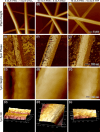Breaking through Electrospinning Limitations: Liquid-Assisted Ultrahigh-Speed Production of Polyacrylonitrile Nanofibers
- PMID: 39744314
- PMCID: PMC11686468
- DOI: 10.1021/acsaenm.4c00657
Breaking through Electrospinning Limitations: Liquid-Assisted Ultrahigh-Speed Production of Polyacrylonitrile Nanofibers
Abstract
Carbon-based nanofibers are critical materials with broad applications in industries such as energy, filtration, and biomedical devices. Polyacrylonitrile (PAN) is a primary precursor for carbon nanofibers, but conventional electrospinning techniques typically operate at low production rates of 0.1-1 mL/h from a single spinneret, limiting scalability. In this study, we introduce a novel liquid-assisted ultrahigh-speed electrospinning (LAUHS-ES) technique that achieved actual production rates over 220 times faster than conventional methods. This dramatic increase in throughput is achieved through Taylor cone stabilization using a thin layer of liquid sheath, allowing for ultrahigh-speed electrospinning without compromising the structural integrity or uniformity of the nanofibers. Comprehensive characterization, including scanning electron microscopy (SEM), atomic force microscopy (AFM), Fourier-transform infrared spectroscopy (FTIR), and X-ray diffraction (XRD), confirmed the high quality, consistency, and crystallinity of the produced nanofibers. Our results demonstrate that PAN nanofiber fabrication can be scaled up significantly while maintaining precise control over fiber morphology and performance. This advancement holds substantial promise for large-scale industrial applications, enabling more efficient and cost-effective production of carbon-based nanofibers.
© 2024 The Authors. Published by American Chemical Society.
Conflict of interest statement
The authors declare no competing financial interest.
Figures








Similar articles
-
Preparation, Stabilization and Carbonization of a Novel Polyacrylonitrile-Based Carbon Fiber Precursor.Polymers (Basel). 2019 Jul 4;11(7):1150. doi: 10.3390/polym11071150. Polymers (Basel). 2019. PMID: 31277462 Free PMC article.
-
High-Speed Electrospinning of Ethyl Cellulose Nanofibers via Taylor Cone Optimization.ACS Appl Eng Mater. 2024 Oct 2;2(10):2454-2467. doi: 10.1021/acsaenm.4c00527. eCollection 2024 Oct 25. ACS Appl Eng Mater. 2024. PMID: 39479565 Free PMC article.
-
High Throughput Centrifugal Electrospinning of Polyacrylonitrile Nanofibers for Carbon Fiber Nonwovens.Polymers (Basel). 2021 Apr 16;13(8):1313. doi: 10.3390/polym13081313. Polymers (Basel). 2021. PMID: 33923640 Free PMC article.
-
High-throughput and high-yield fabrication of uniaxially-aligned chitosan-based nanofibers by centrifugal electrospinning.Carbohydr Polym. 2015 Dec 10;134:467-74. doi: 10.1016/j.carbpol.2015.07.097. Epub 2015 Aug 1. Carbohydr Polym. 2015. PMID: 26428148 Free PMC article.
-
Antibacterial properties of in situ and surface functionalized impregnation of silver sulfadiazine in polyacrylonitrile nanofiber mats.Int J Nanomedicine. 2019 Apr 16;14:2693-2703. doi: 10.2147/IJN.S197665. eCollection 2019. Int J Nanomedicine. 2019. PMID: 31354260 Free PMC article.
References
-
- Kenry; Lim C. T. Nanofiber technology: current status and emerging developments. Prog. Polym. Sci. 2017, 70, 1–17. 10.1016/j.progpolymsci.2017.03.002. - DOI
-
- Lang C.; Wang H.; Fang J.; Jin J.; Peng L.; Lin T. Recent advances in acoustoelectric conversion of piezoelectric electrospun nanofibers. Nano Energy 2024, 130, 110117.10.1016/j.nanoen.2024.110117. - DOI
-
- Schoolaert E.; Cossu L.; Becelaere J.; Van Guyse J. F. R.; Tigrine A.; Vergaelen M.; Hoogenboom R.; De Clerck K. Nanofibers with a tunable wettability by electrospinning and physical crosslinking of poly(2-n-propyl-2-oxazoline). Mater. Des. 2020, 192, 108747.10.1016/j.matdes.2020.108747. - DOI
LinkOut - more resources
Full Text Sources
Miscellaneous
